What Is Sprint Grooming? Guide (2026)
Discover sprint grooming, its purpose in agile development, and tips for preparing backlog items for upcoming sprints.

Early‑stage teams often juggle competing demands. One week you’re reacting to a major customer request, the next you’re fixing debt that your last release exposed. With limited resources, there’s little margin for mis‑aligned work or idle developers.
The question of what is sprint grooming often comes up when founders or product leads notice that their backlog is chaotic and their sprint planning sessions are unproductive. Sprint grooming — sometimes called backlog refinement — gives your team a regular chance to organise, discuss and prepare work before committing.
This guide is for founders, product managers, designers, engineers and anyone tasked with bringing direction to young product teams. We’ll look at why grooming matters, what happens during a grooming session, how it differs from sprint planning, and share practical guidance drawn from agile research and our own client work.
What Is Sprint Grooming?
Sprint grooming, also known as backlog refinement, is a regular team activity where the top items in the product backlog are reviewed to ensure they’re clear, estimated, and prioritized. This process helps product teams prepare work for the upcoming sprint, avoid planning delays, and keep development focused on current goals.
Why does grooming matter when you move fast?
Agile development embraces change through iterative cycles, lightweight documentation and continuous improvement. Core to many agile frameworks is the product backlog, an ordered list of everything your team might build. Items at the top of the backlog feed the next sprint backlog, which contains the work that will actually be delivered in the upcoming iteration. When the backlog grows without active care, priorities drift and vague ideas clog the top of the list. The Agile Alliance notes that backlog refinement (formerly backlog grooming) is a regular activity where the product owner and team review backlog items to ensure the list contains the appropriate work, that items are prioritised, and that the top entries are ready for delivery. Their glossary emphasises that refinement sessions can be scheduled or continuous and include removing outdated user stories, reassessing priority, assigning estimates and splitting stories that are too large.
Most guides today prefer the term “refinement” because of the negative associations of grooming, but many startup teams still ask about what is sprint grooming. In essence, it is refinement performed with the next sprint in mind. According to the Nielsen Norman Group’s Lean‑UX glossary, backlog refinement meetings help prioritise and prepare items for the next sprint and usually happen halfway through the current sprint. When teams neglect this routine, they find themselves debating requirements during planning, building features out of order and reacting to last‑minute surprises. In our work with AI and SaaS startups, unrefined backlogs created idle time: engineers waited for clarification while product leaders tried to recall why a story was important. Meanwhile, marketing demands slipped because the backlog had grown stale.
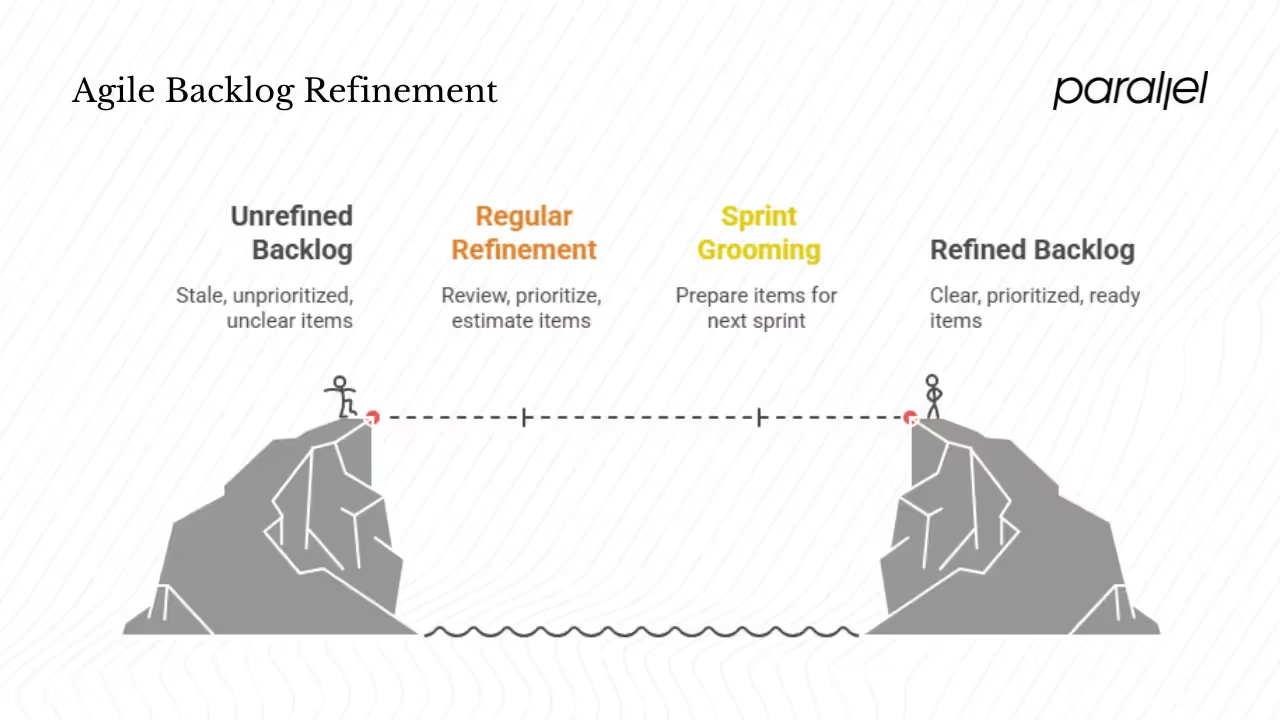
Regular grooming prevents that chaos. Monday.com’s 2025 guide says that backlog refinement makes sprint planning three times faster because the work is already clear and estimated. The same guide recommends spending about 10% of your sprint on refinement and focusing on the next two or three sprints of work to keep preparation aligned with shifting priorities. By investing a small slice of time, you save hours of frustration and reduce rework.
What is sprint grooming and why do it?
So what is sprint grooming exactly? In simple terms, it is a collaborative process where a product owner, scrum master and development team review the top backlog items to make sure they are clear, estimated and prioritised for the upcoming sprint. Items that are no longer relevant are removed; large epics are split into manageable user stories; acceptance criteria are added; and estimates are updated. Agile Alliance summarises the intent as keeping the backlog populated with items that are relevant, detailed and estimated in line with the current understanding of the project.
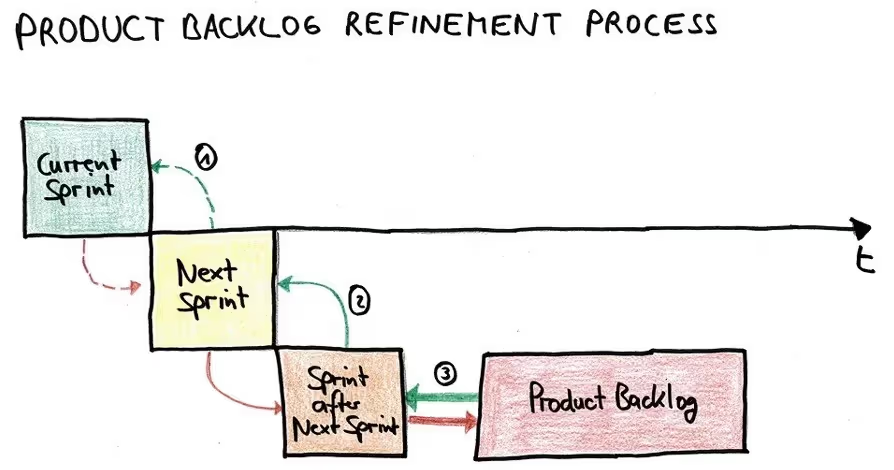
This preparation achieves several objectives:
- Clarity: Items are no longer one‑line notes or vague requests. Acceptance criteria spell out when a story is done. Nielsen Norman Group stresses that clear criteria prevent misunderstandings and delayed releases.
- Alignment: The team agrees on why each item matters and how it serves the product vision. Stakeholders can see that the backlog reflects current strategy rather than random ideas.
- Readiness: Stories are small enough to fit in a sprint and estimated so that the team can commit confidently.
- Risk reduction: Technical risks and dependencies surface early, giving the team time to research or adjust plans.
Grooming sessions typically involve the product owner (or founder), who provides business context; the scrum master or facilitator, who keeps the discussion on track; and a cross‑functional development team. Monday.com emphasises that involving the whole team helps catch technical issues early and build shared understanding. Depending on the feature, designers or stakeholders might join to clarify user experience considerations or regulatory constraints. In my experience, inviting design leads early prevents costly rework because edge cases and interactions are addressed before code begins.
Frequency varies by team, but the practice should be continuous. Some teams hold one mid‑sprint session; others split it into shorter weekly sessions. Monday.com advises dedicating around 10% of your sprint capacity to refinement. For a two‑week sprint, that might be a one‑hour meeting plus ad‑hoc touch points. Early‑stage teams with rapidly changing priorities often benefit from more frequent, shorter touch points to keep up with customer feedback.
Inside a grooming session: activities and best practices
During grooming you don’t just read through the backlog — you actively shape it. Here are the key activities and how to approach them.
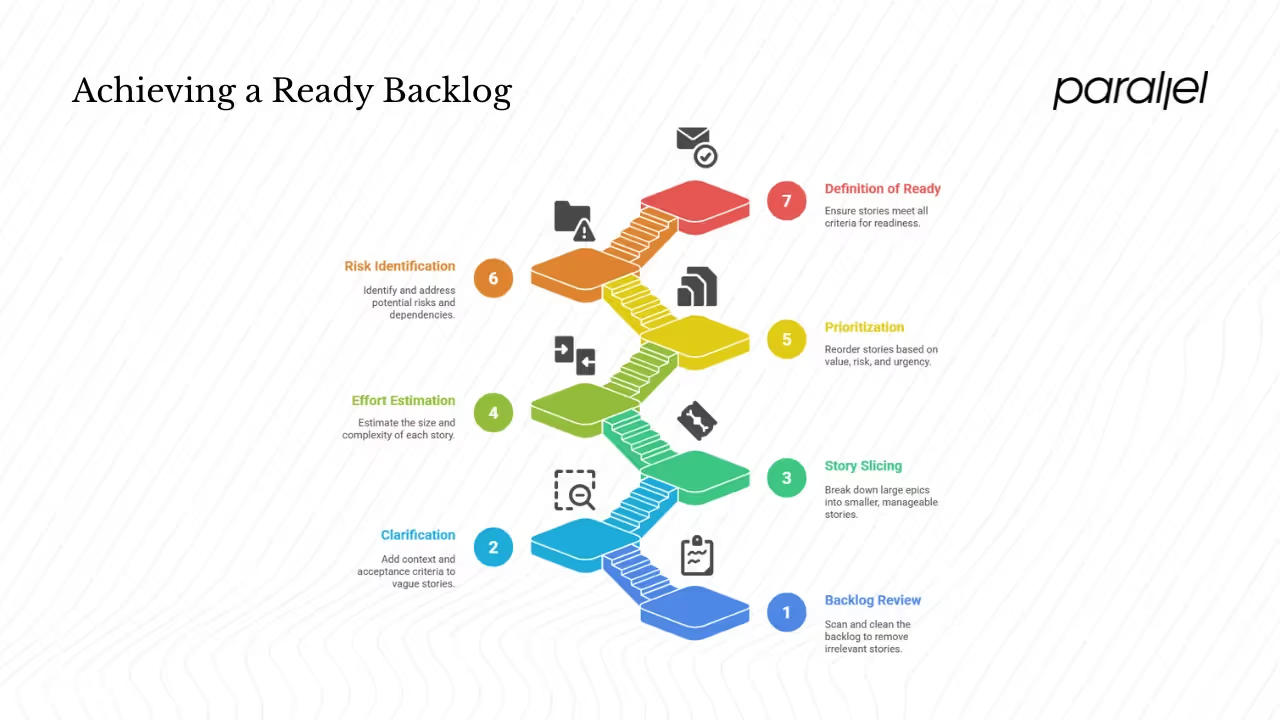
1) Backlog review and cleanup
Start by scanning the backlog for relevance. Remove stories that no longer align with your goals. Merge duplicates and discard “good ideas” that have lost urgency. Agile Alliance lists removal of irrelevant user stories and reassessing priority among core refinement activities. Keeping the backlog lean prevents information overload and highlights what truly matters.
2) Clarification and specification
Vague stories slow teams down. Add missing context, acceptance criteria and dependencies. Nielsen Norman Group notes that acceptance criteria are written in plain language from the user’s perspective and ensure that everyone understands what needs to be built. Encourage developers to ask questions and designers to outline edge cases. If you don’t know all the details, capture them as follow‑up tasks or research spikes.
3) Story slicing and decomposition
Large epics should be broken down until each story fits comfortably within a sprint. Agile Alliance suggests splitting high‑priority stories that are too coarse‑grained to fit in an iteration. We often look for vertical slices that deliver a piece of end‑to‑end functionality rather than horizontal layers. For example, instead of “Implement payment system,” create separate stories for “Add credit‑card input,” “Validate payment,” and “Handle errors.”
4) Effort and complexity estimation
Once stories are clear, the team estimates their size. Use relative sizing methods such as story points (Fibonacci), T‑shirt sizes or modified numbers. Monday.com emphasises that effort estimation is part of refinement and that having agreed‑upon estimates before planning makes planning smoother. Involve the whole development team in estimating so everyone shares ownership and raises concerns. If there’s significant disagreement, revisit the story’s assumptions or slice it further.
5) Prioritisation and ordering
With clarity and estimates in hand, reorder the backlog based on value, risk, dependencies and urgency. Frameworks like RICE (Reach, Impact, Confidence, Effort), WSJF (Weighted Shortest Job First) or MoSCoW can help you reason about trade‑offs. Our own backlog prioritisation guide recommends balancing customer value, user evidence, mission fit, complexity, dependencies, risk, urgency and resource availability. Remember that the backlog is ordered, not simply tagged with high/medium/low. The goal is to maximise value delivered per sprint.
6) Risk identification and dependencies
Use grooming to surface technical risks and cross‑team dependencies. If a story requires input from another team or integration with a third‑party service, flag it early. When uncertainty is high, create a “spike” — a time‑boxed research task — and prioritise it ahead of development so that planning isn’t derailed later. This risk‑driven approach improves predictability and reduces mid‑sprint surprises.
7) Definition of Ready check
Before leaving a story at the top of the backlog, run through a simple checklist: Is the purpose clear? Do we have acceptance criteria? Is it small enough? Are dependencies identified? Does the team agree on the estimate? If any answer is no, keep refining or park it lower in the backlog. Monday.com notes that using a Definition of Ready ensures items meet agreed‑upon standards and makes planning sessions quicker.
Sprint grooming vs sprint planning
Teams often confuse grooming and planning because both involve backlog items. Here’s how they differ:
Sprint planning occurs once per iteration and answers “What can we commit to?” Grooming happens continuously and ensures the backlog is in shape before planning. Monday.com explains that refinement is an ongoing activity where the team reviews, prioritises and estimates upcoming items to make sure they’re clear. Planning, in contrast, is a time‑boxed ceremony at the start of the sprint to decide what will be delivered. When grooming precedes planning, teams spend minutes selecting work instead of hours debating requirements.
How often to groom: guidelines for early‑stage teams
There is no one‑size‑fits‑all cadence for grooming. However, several principles apply:
- The 10% rule: Allocate roughly one‑tenth of your sprint capacity to grooming and refinement. For a two‑week sprint this might be one mid‑sprint session and a few short follow‑ups.
- Adjust to change: If your priorities change frequently or your backlog is growing quickly, schedule more frequent, shorter sessions. Conversely, if your backlog is stable and you work on longer‑term initiatives, less frequent sessions may suffice.
- Consider team size: Larger teams may need more structured sessions to ensure everyone is heard. Smaller startups can stay lightweight and rely on ad‑hoc conversations plus a weekly review.
- Use real‑time tools: Digital boards like Jira, Trello or Notion help visualise status and allow continuous updates. Keep them open during sessions so everyone sees the same information.
In practice, many early‑stage teams use one medium‑length grooming session mid‑sprint, supplemented by quick mini‑groomings whenever new ideas arrive. Others split the work into two shorter sessions per sprint to avoid fatigue. What matters is that you never arrive at sprint planning with un‑prioritised, unclear work.
Practical tips for startup teams
Drawing on years of supporting AI and SaaS founders, here are specific tips to make grooming productive:
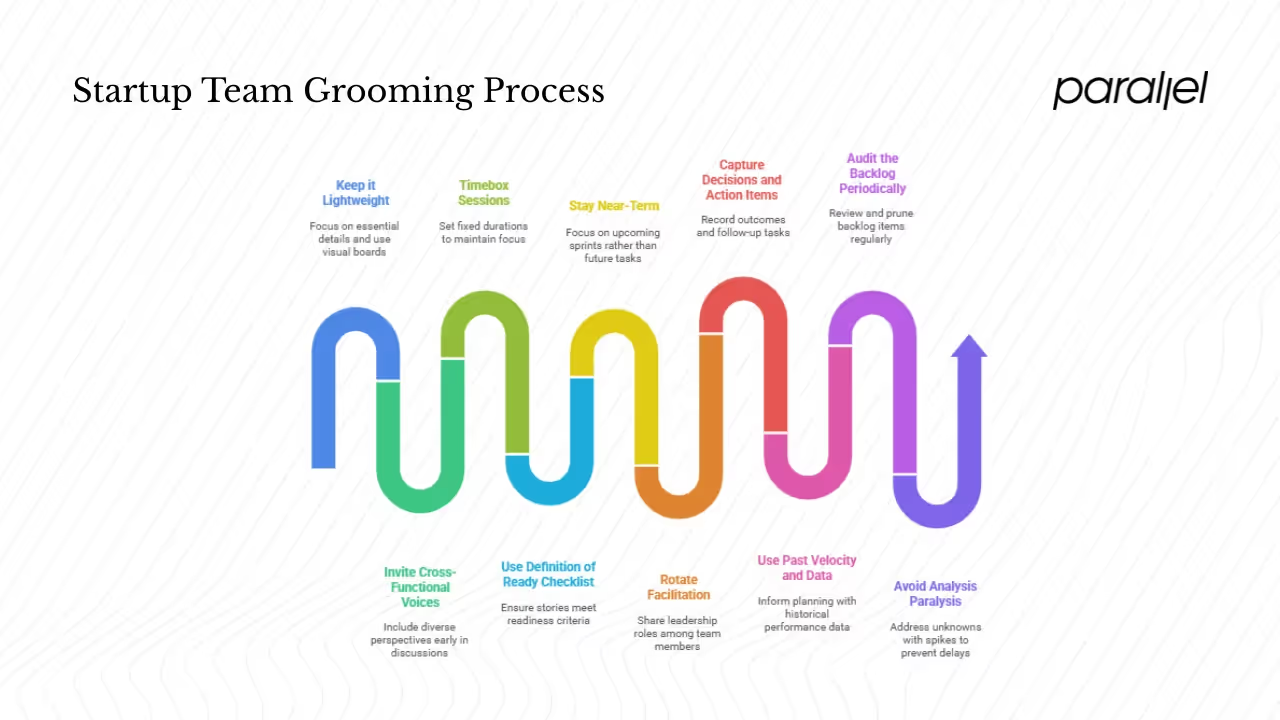
- Keep it lightweight. Don’t over‑document. Capture just enough detail to move forward. Use visual boards so everyone sees the status.
- Invite cross‑functional voices. Bring designers, researchers and stakeholders into the conversation early. Monday.com points out that cross‑functional participation closes a perception gap between leaders and contributors.
- Timebox sessions. Agree on a fixed duration and stick to it. This keeps discussions focused and prevents endless debates.
- Use a Definition of Ready checklist. A simple template ensures stories are truly ready. If an item doesn’t meet the criteria, park it or assign a follow‑up.
- Stay near‑term. Don’t over‑refine work that is far in the future. Focus on the next few sprints. Monday.com suggests keeping preparation to the next two or three sprints.
- Rotate facilitation. Give different team members a chance to run grooming sessions. This builds shared ownership and avoids reliance on a single voice.
- Capture decisions and action items. Use meeting notes or comments in your tool to record why priorities changed, what estimates were agreed and what follow‑ups are required. This reduces confusion later.
- Use past velocity and data. Look at how much work your team completes per sprint and factor that into your planning. Data helps anchor discussions and avoid unrealistic commitments.
- Audit the backlog periodically. At least once a quarter, step back and prune the backlog more aggressively. Remove stale ideas and reorganise based on current strategy.
- Avoid analysis paralysis. If a story can’t be refined because of unknowns, flag it as a spike rather than letting it block the backlog. Then prioritise the spike to gain the needed knowledge.
Common pitfalls and how to avoid them
Despite good intentions, grooming sessions can become counter‑productive. Watch out for these traps:
- The dumping ground: Without discipline, the backlog becomes a repository for every idea. Avoid adding items without a clear rationale. Encourage team members to bring supporting evidence or customer feedback.
- Over‑refining the distant future: Spending hours detailing work that won’t start for months wastes time. Focus on the immediate horizon and revisit longer‑term items later.
- Skipping grooming: When teams skip refinement, sprint planning becomes chaotic. Unclear stories cause debates, resulting in unrealistic commitments and missed deadlines. Make grooming a non‑negotiable part of your process.
- Single‑voice dominance: If the product owner or a stakeholder dictates priorities without discussion, you miss important technical and user‑experience input. Encourage everyone to ask questions and challenge assumptions. Use poker‑style estimation to give quieter voices space.
- Inconsistent estimation: Changing between story points, hours and other units confuses velocity tracking. Pick one method and stick with it. Re‑evaluate only when there’s consensus that the current system isn’t working.
- Ignoring dependencies and risks: Failing to surface technical or organisational dependencies leads to blocked work mid‑sprint. Build risk identification into your grooming checklist.
- Oversized meetings: Inviting too many people can slow progress. Limit attendance to those who can contribute. Others can review notes or join when a specific topic affects them.
- Ballooning effort: Track how much time grooming consumes. If sessions routinely run long or feel unproductive, shorten them or break them into smaller meetings focused on specific topics.
Measuring success and continuous improvement
How do you know whether grooming is working? Look for signals such as:
- Smooth sprint planning. Planning sessions should be shorter and more focused on capacity and commitment rather than requirement debates. Monday.com notes that clear acceptance criteria and estimates enable planning to proceed in minutes instead of hours.
- Fewer blocked stories. When items are well‑refined, teams encounter fewer mid‑sprint blockers and context switches.
- Reduced scope changes mid‑sprint. With clear priorities, you’re less likely to swap stories mid‑iteration.
- Items more often “ready.” Over time you’ll notice that more backlog items meet your Definition of Ready before planning.
- Improved predictability. Mature refinement practices allow you to forecast more accurately and build trust with stakeholders.
Continuous improvement is central to agile. Use retrospectives to discuss how grooming sessions felt. Adjust their frequency, length or participants as needed. Experiment with different estimation methods or prioritisation frameworks. As your team grows, revisit roles and hand off facilitation. Remember that refinement is a means to an end — delivering valuable features predictably. If a ritual no longer serves that goal, change it.
A hypothetical scenario: from chaos to clarity
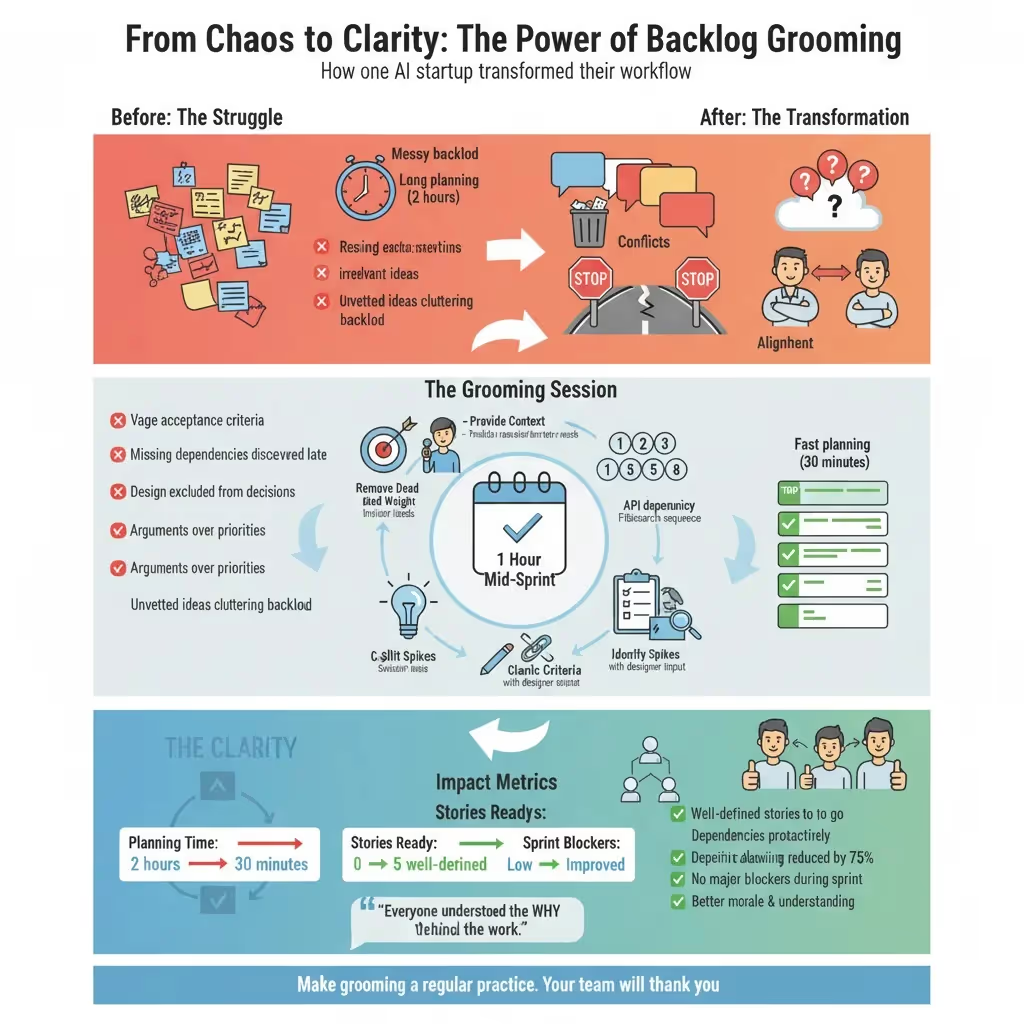
Imagine a small AI startup building a workflow tool. The backlog started as a long list of ideas collected from customer calls. During sprint planning, the team argued about what to build next. Engineers pointed out that some high‑priority items depended on unfinished infrastructure. Design felt left out of decisions. Halfway through the sprint, they discovered they couldn’t complete a top story because the acceptance criteria were unclear.
We worked with this team to introduce grooming. First, we scheduled a one‑hour session mid‑sprint. The product owner provided context on upcoming customer demos. Together, we removed ideas that were no longer relevant. An epic called “Reporting dashboard” was split into stories like “Add daily summary card,” “Implement export to CSV,” and “Build filter control.” Developers estimated each item using Fibonacci points and highlighted a dependency on an analytics API that hadn’t been built. We created a spike story to research the API. The designer clarified the acceptance criteria for the summary card and mocked up the layout.
At the next sprint planning session, the team had five well‑defined stories at the top of the backlog. They selected those that fit their capacity and committed with confidence. Planning took 30 minutes instead of two hours. During the sprint, there were no major blockers because the spike story had resolved the API uncertainty. After a few cycles, the backlog remained lean and reflected actual priorities rather than unvetted ideas. The founder reported that the team delivered more consistently, and morale improved because everyone understood the why behind the work.
Conclusion
In fast‑moving startups, speed shouldn’t come at the expense of direction. What is sprint grooming? It’s not just another meeting. It’s a structured way to give your product backlog the attention it deserves. By continuously reviewing, clarifying, sizing and prioritising work, you create a shared understanding of what matters and reduce the chaos that saps momentum. Evidence from industry shows that regular refinement makes sprint planning three times faster and keeps the backlog healthy. Your team spends less time debating and more time building. It’s a small investment — about 10% of your sprint — that yields outsized returns in predictability and focus.
As you adopt or refine your grooming practice, start small. Pick a cadence, invite the right people and use a Definition of Ready checklist. Learn from each session and tweak your process. Early‑stage teams thrive when they combine agility with discipline. If you’re still wondering what sprint grooming is, the short answer is that it’s your opportunity to turn a messy backlog into an asset that guides your next move. Try it with your team and see how much smoother your sprints can be.
Frequently asked questions
1) What is the purpose of sprint grooming?
Sprint grooming ensures that the top items in the backlog are clear, estimated and prioritised so that the team can commit confidently during planning. It reduces ambiguity, surfaces technical risks and aligns everyone around the why and what of upcoming work. Without grooming, planning sessions become lengthy debates and work often stalls mid‑sprint.
2) How many grooming sessions should we have per sprint?
There’s no fixed number. A common guideline is to spend about 10% of your sprint time on refinement. For a two‑week sprint, that might mean a one‑hour session plus a few shorter check‑ins. Adjust frequency based on team size, rate of change and backlog complexity. Continuous light grooming often works better than infrequent long meetings.
3) What comes first, sprint planning or grooming?
Grooming should precede planning. Grooming is an ongoing activity where you prepare backlog items by clarifying, splitting and estimating them. Sprint planning is a time‑boxed meeting at the start of the sprint where the team commits to a set of refined stories. When grooming happens ahead of planning, the planning session is focused on capacity and commitment rather than requirements.
4) What is the difference between sprint grooming and sprint planning?
Sprint grooming is about keeping the backlog healthy; it happens throughout the sprint and focuses on clarification, estimation and prioritisation. Sprint planning is a formal meeting that marks the start of a sprint. During planning, the team selects the refined stories they will deliver and crafts a sprint goal. Grooming is about getting ready; planning is about committing.
5) Who should attend sprint grooming?
At minimum, the product owner, scrum master and development team should participate. Designers, researchers or stakeholders join when their expertise is needed. Monday.com encourages involving the whole team to build shared understanding and catch technical issues early.
6) How long should a grooming session last?
Keep sessions short and focused. One hour is a good starting point for a two‑week sprint. Longer or more complex backlogs may need slightly more time, but avoid letting meetings run too long. If you find yourself discussing details unrelated to the immediate horizon, park the conversation and schedule a separate deep dive.

.avif)











